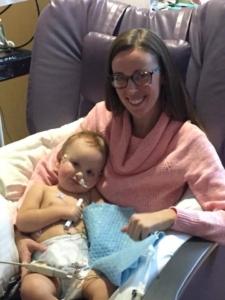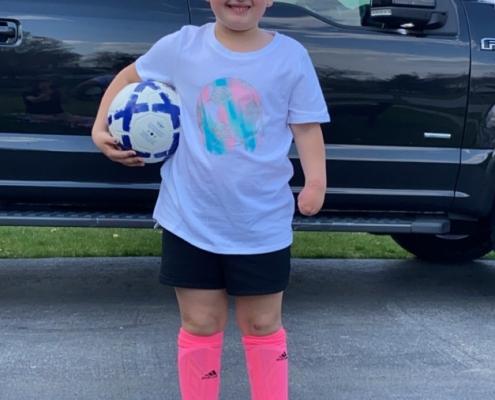Kailyn Bever was just 18 months old when her stroke story began. She was a healthy child who loved books and playing with her dog, Rambo, in her hometown of Toledo, Ohio. One day, she started feeling unwell, so her parents made an appointment with her doctor.

“When we first took her in, we were told to just have her rest and drink plenty of fluids,” said her mother, Shauna Robison. “But after a week, she seemed to be getting more ill and had a fever we could not control.”
Kailyn had developed pneumonia, which was causing the fever as well as difficulty breathing, but another problem was lurking that the family had no idea was a possibility for their young daughter.
“One day as I was nursing her, I noticed her left arm was cold to touch, more so than normal,” said Shauna. “We covered her with a blanket and turned the heat up.” A few days later, her symptoms progressed to vomiting and loss of balance.
Kailyn had experienced multiple ischemic strokes, including a total occlusion of her basilar artery and left subclavian artery, blocking blood supply to her arm. She was life flighted to C.S. Mott’s Children’s Hospital in Michigan.
The family was shocked to learn that stroke was the culprit. And as such a diagnosis was so uncommon in children Kailyn’s age, there were no case studies to reference and no prior experiences in the hospital either.
It was eventually decided that thrombectomy was the best course of treatment to “fish out” the clot. This was risky, as children’s arteries are very small and have a tendency to go into spasm with placement of a catheter. But her care team — including neuroendovascular surgeon Dr. Joseph Gemmete — was able to remove most of the clot and administer heparin to dissolve the rest.
“There are no large thrombectomy trials including younger patients presenting with an acute ischemic stroke,” said Dr. Gemmete. “More research needs to be performed in this population. At the same time, we need more education and public awareness about stroke in the pediatric population.”

On Christmas Day 2016 Kailyn was taken off of life support and was breathing on her own. Unfortunately, the clot arm dissolved so slowly that her fingers were unable to be saved.
Two months after coming home, Kailyn began talking and crawling again. Two months after that she began walking again.
“I would definitely tell other parents of young children that when something is wrong with them, just keep trying to find answers,” Shauna said. “Don’t stop until you get the answer.”
The family consented to the Neurointerventional Radiology team at Mott’s to write a case report on Kailyn so that other children in her situation may benefit from this life-saving treatment.
“What we learned from Kailyn’s experience is that young children can have a stroke,” said Dr. Gemmete. “The symptoms are usually a little different than an adult, as are the causes. But the time-sensitive nature of the condition is the same.”
Nearly five years later, Kailyn continues to go to physical and occupational therapy weekly. While she experiences several deficits related to her vision and facial paralysis, she is determined to overcome her disabilities.
“Stroke is still an abstract concept for Kailyn,” Shauna said. “We tell her that when she was a baby her brain got hurt. She wants to be a normal kid and have all her fingers, so we buy her lots and lots of books about kids who are born different or have had strokes. These have been a real blessing. And now, she is unstoppable!”
Read more about Kailyn’s incredible story in the January 4, 2024, issue of People magazine.



